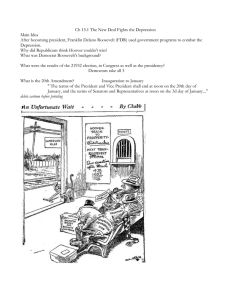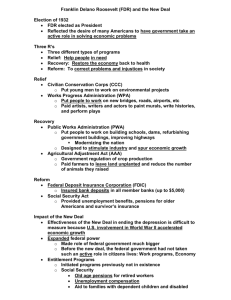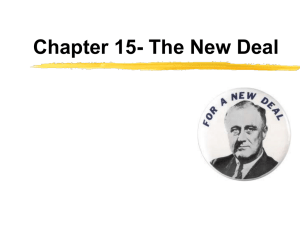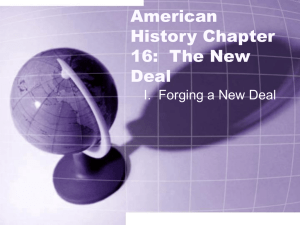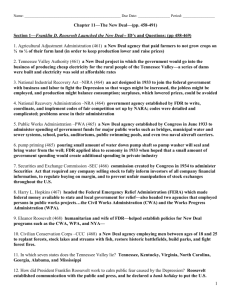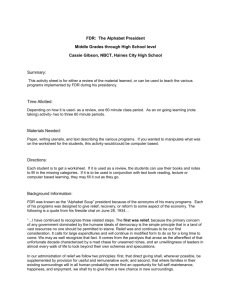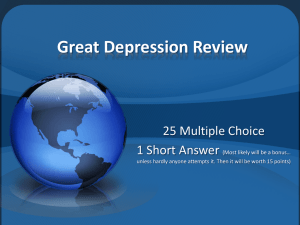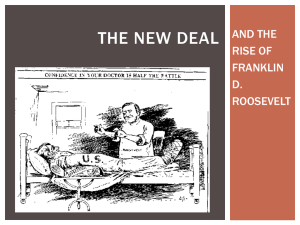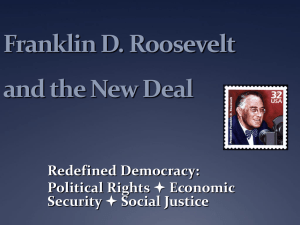The New Deal
advertisement
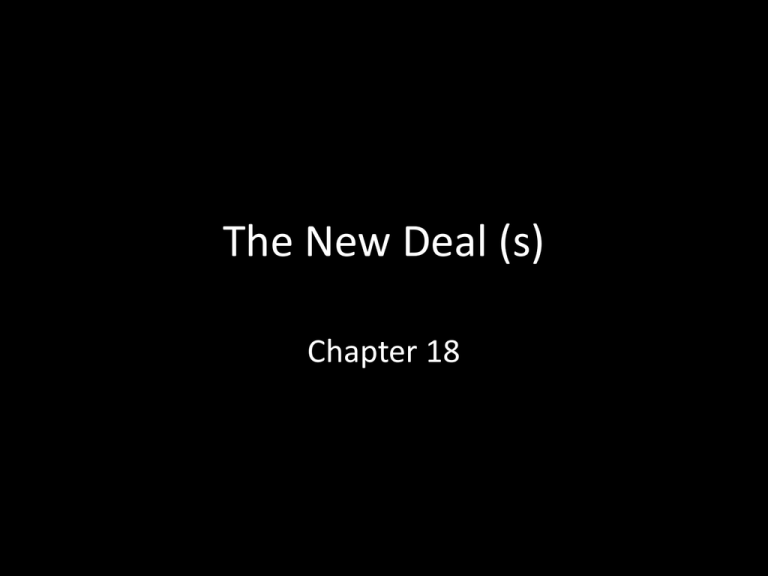
The New Deal (s) Chapter 18 Major Themes • Expansion of the Federal Government's power • The New Deal: Relief, Reform, Recovery • Changes in the relationship/roles between the Federal Government and the People. Franklin Delano Roosevelt • Grew up very privileged – “Traitor to His Class” H.W. Brands • Graduated from Harvard/Columbia Law School • Contracted Polio at 39 – Helped found the March of Dimes • Governor of New York 19291932 Election of 1932 Americans view FDR as energetic, optimist, and a leader Franklin Delano Roosevelt (FDR) elected president on his promises of a more proactive federal government FDR Win’s 88.8% of electoral vote 57.42% of popular vote (Hoover 11.1% electoral, 39.64% popular) The first 100 Days “The country needs bold persistence and experimentation. Above all else…try something” • The New Deal: FDR’s program for combating the Depression – Relief, Recovery, Reform • immediately starts sending bill after bill to Congress – Congress passes 15 major pieces of legislation Emergency Banking Relief Act – closed all banks for investigation. Allowed honest ones to reopen Fireside Chats – radio broadcasts where FDR talks directly Americans; explains his initiatives “The only thing we have to fear, is fear itself.” Reform Security and Exchange Commission (SEC) – regulated stock exchange and prevented fraud Glass-Steagall Act – separated commercial banking from investment banking Federal Deposit Insurance Corporation (FDIC) – provided government insurance for bank deposits up to a certain amount Relief • Economic conditions prompted government intervention to create jobs by instituting new programs • Tenessee Valley Authority (TVA) – brings electrical power to poverty-stricken rural areas of Tennessee, Mississippi, Alabama and other states; also provided jobs to the area. • Civilian Conservation Corps(CCC) – Offered young men jobs in national forestry services • Public Works Administration (PWA) – Federal relief agency, which initiated construction projects to build highways, dams, sewer systems, and other gov. facilities. • Civil Works Administration (CWA) & Works Progress Administration (WPA) – Hired workers directly and put them on gov payroll Relief/Reform Farming Agricultural Adjustment Administration (AAA): paid farmers not to grow food to raise crop prices Killed livestock to raise meat prices Large commercial farmers mostly benefitted Small farmers, many poor black and white sharecroppers hurt by program Reform • Industry National Industrial Recovery Act (NIRA) suspended anti-trust laws businesses, labor, and government set rules National Recovery Administration (NRA) ran the program set up by the NIRA Businesses that agreed to rules were given the Blue Eagle to show participation Opposition from Right • Unemployment still high • FDR gaining opposition, especially b/c of his deficit spending – Keynesian economics Opposition from the left • Huey Long (D) LA Senator Populist / Boss of political machine Most serious threat; believed New Deal hadn’t gone far enough Attacked the rich Established 27,000 “Share Our Wealth” clubs Harms” American Dream” Assassinated 1935 Opposition Father Coughlin Populist; Popular radio show Called for heavy taxes on wealthy and nationalization of banking system Dr. Francis Townsend • The Townsend Plan Proposed federal government pay pension of $200 to every citizen over age 60 Free up jobs Elderly rallied to Townsends side Both men were threatening as a possible 3rd party, which would assure a Republican victory The Second New Deal • Second New Deal launched to speed up recovery • Works Progress Administration (WPA) Employed workers in public works projects (roads, dams, airports, etc.) Artists, Actors & musicians employed Social Security Act Provided financial security for older Americans, unemployed workers, modest welfare payments Workers earned right to receive benefits through payroll tax Unions • 1935 Congress passes the Wagner Act – Guarantees workers the right to bargain and organize – Binding arbitration: dissatisfied union members could take their complaints to a neutral 3rd party • The Committee for Industrial Organization (CIO) – organized labor where it did not yet exist especially in auto and steel industries • Sit-Down Strikes – workers stop working but refuse to leave the factory Constitutional Issues • Butler v US – Ruled unconstitutional because it “…is a statutory plan to regulate and control agriculture production, a matter beyond the powers delegated to the federal government” • Schechter v US – “sick chicken case” – Schechter brothers violated NIRA’s Live Poultry Code – Court ruled the Constitution did not allow Congress to delegate its powers to the executive branch; ruled NIRA codes unconstitutional Constitutional Issues • Court-Packing! – FDR upset that courts keep shooting down New Deal legislation – FDR sends Congress a bill that would increase the number of justices, and allow the president to appoint an additional Justice, up to a maximum of six, for every member of the court over the age of 70 years and 6 months – Hilarity ensued Recession • Roosevelt Recession Output levels rose to pre-Depression highs, everyone thought the Depression was coming to an end 1937 Roosevelt makes slight cuts to some New Deal Programs Unemployment surged Proof that New Deal Legislation was beneficial? Legacy Late 1930’s saw more resistance to FDR from Republicans and Southern Democrats New Deals had limited success in dealing with Depression Federal government's powers expanded enormously Broker State – US government working out conflicts between different groups Safety Net – safeguards and programs that protected Americans from economic disaster
